Discover the magic of the Canadian Rockies with this detailed 2-week road trip itinerary. Complete with campground suggestions and hiking adventures.

Trip Overview
- Total Days: 12-13
- Total Distance: 2035 km / 1264 miles
- Suggested Time of Year: Mid July to early September
Trip Notes
- START AND END: Living in Vancouver, BC, we have the advantage of driving straight from home. Depending on your location, you may choose to begin and end this trip elsewhere. If you’re flying in, I recommend starting in Calgary to cut down on driving time.
- NATIONAL PARKS: Given the popularity of the Canadian Rockies’ national parks, planning ahead is essential. Campsites book up quickly, so be sure to reserve in advance. I’ve included the reservation opening dates throughout the itinerary to help with planning.
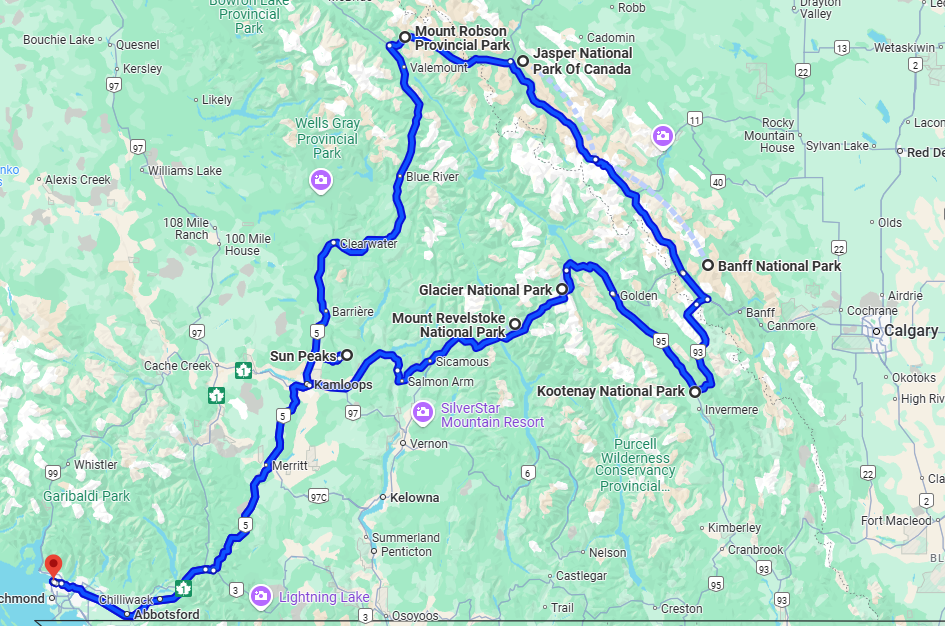
Trip Inspiration
Though it’s over a 10-hour drive from Vancouver, the Canadian Rockies have always felt like an extension of my own backyard. I was lucky enough to visit a few times as a kid, usually while passing through on family trips to Calgary. But it wasn’t until the summer of 2021 that I truly got to slow down and soak in their magic. This itinerary follows that unforgettable adventure and my rediscovery of just how awe-inspiring the Canadian Rockies are.
However, the following itinerary was not the original plan. We had originally scored the golden ticket — a 3-night backpacking permit for the Berg Lake Trail in Mt. Robson — and built our entire trip around it. Anyone who’s tried to book Berg Lake knows what a win that is! But in early July 2021, an intense heatwave triggered rapid snowmelt, causing the Robson River to flood, washing out bridges, and closing the trail beyond Kinney Lake indefinitely. With our permit dates in late July, we had no choice but to pivot and come up with a new plan.
And that wasn’t the only time Mother Nature threw a wrench in our Rockies plans. In the summer of 2024, we had another epic trip lined up — a 3-night backpack along the Skyline Trail in Jasper for late August. But once again, nature had other ideas. A devastating wildfire swept through Jasper in late July, shutting down the park for the rest of the season and once again cancelling our plans.
I’m not sharing this to discourage you from visiting the Rockies — quite the opposite! I hope it inspires you to experience their beauty while you can. But these stories are a good reminder that while itineraries are helpful, any adventure into nature requires flexibility. Sometimes, the best stories come from the unplanned detours. The itinerary below blends parts of our original plan with the incredible new adventures we discovered along the way.
Day 1 – Vancouver to Revelstoke NP
- Drive Time: 6hr 15 min (565 km / 351 mi)
- Where to Stay: Snowforest Campground or Lamplighter Campground
- When to reserve: January of year you want to travel (see Parks Canada for booking date)
- Suggested Stops:
- Three Valley Gap Lookout
- The Enchanted Forest
The first day of the trip is the longest stretch of driving — mostly to put the coast in the rearview and get to the Rockies as quickly as possible. We didn’t make many stops along the way, aside from a few bathroom breaks and a quick stop for lunch. My favorite part of this drive begins just after Salmon Arm, where Highway 1 narrows into a charming two-lane road that winds through Three Valley Gap. This portion is incredibly scenic and always reminds me of just how stunning British Columbia’s natural beauty can be.
Once you arrive in Revelstoke, there are a few great options for where to stay. We camped at Snowforest Campground and absolutely loved it. That said, Parks Canada has since put a ban on tent camping there, so if you plan to stay at Snowforest, you’ll need hard-sided camping equipment. If you’re tent camping, a great alternative is Lamplighter Campground, located just outside the park.
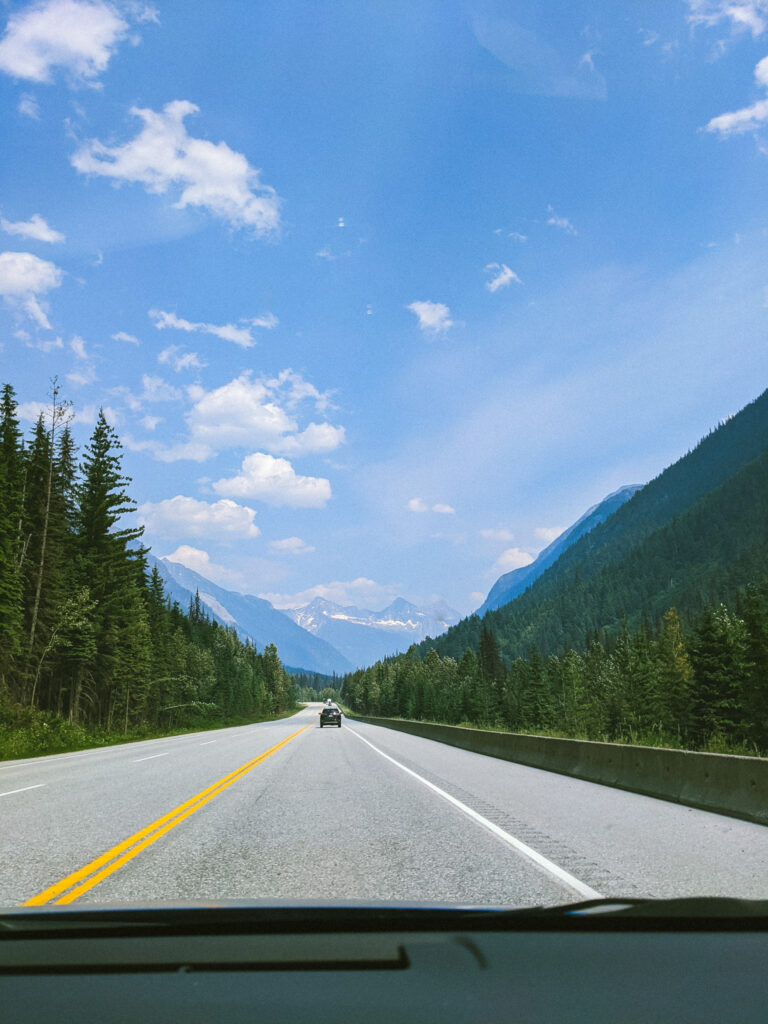
Day 2 – Revelstoke NP to Glacier NP
- Drive Time: 50 min (63 km / 39 mi)
- Where to Stay: Loop Brook Campground or Illecillewaet Campgound
- When to reserve: January of year you want to travel (see Parks Canada for booking date)
- Suggested Stops:
- Meadows in the Sky Parkway
- Great Glacier Trail
Day two takes you off the road and onto the trails, with a much shorter drive than the day before. Since there’s less ground to cover, you can enjoy a slow morning — take your time packing up camp and make sure to stop and soak in Mount Revelstoke before continuing on to Glacier National Park.
We began the day with a drive up the Meadows in the Sky Parkway, where we stretched our legs on a short scenic walk through Mount Revelstoke’s stunning subalpine landscape. If you’re only visiting for a day, this is the perfect way to experience the park’s beauty. We found the perfect spot for a packed lunch with mountain views before heading off toward Glacier.
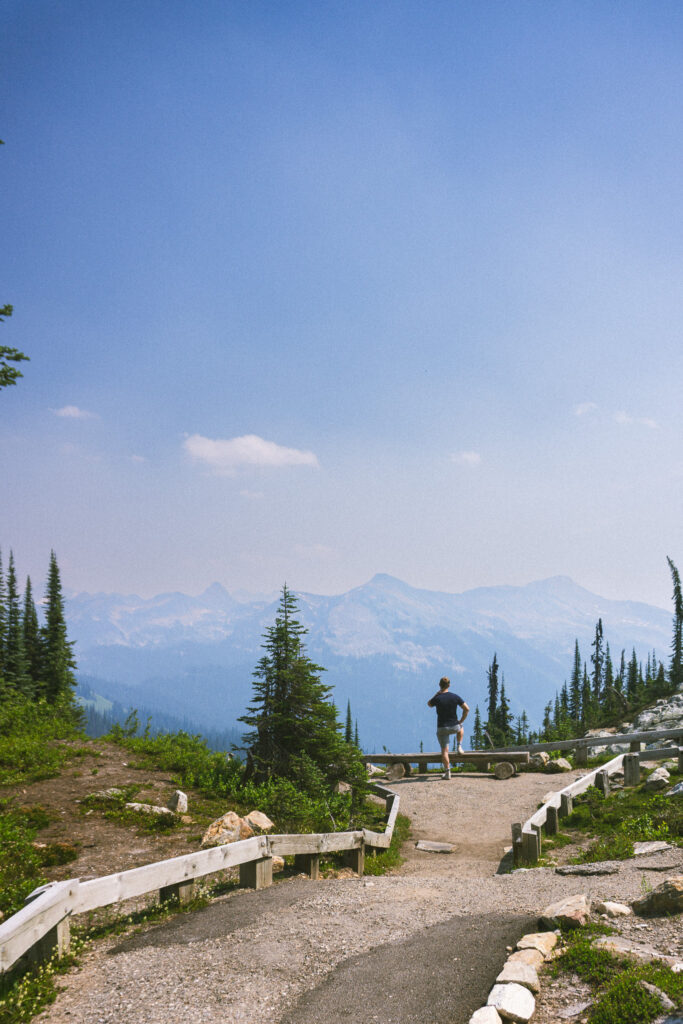
If your schedule allows, this is where I’d recommend adding extra time. With just one night in Glacier National Park, we went straight to the trails before even setting up camp. Choosing just one hike here is tough — there are so many great options. I’d love to return one day to tackle some of the park’s more challenging backpacking routes. For this trip, we opted for the iconic Great Glacier Trail, which offered a magical glimpse into the park’s landscape and history in just a few short hours.

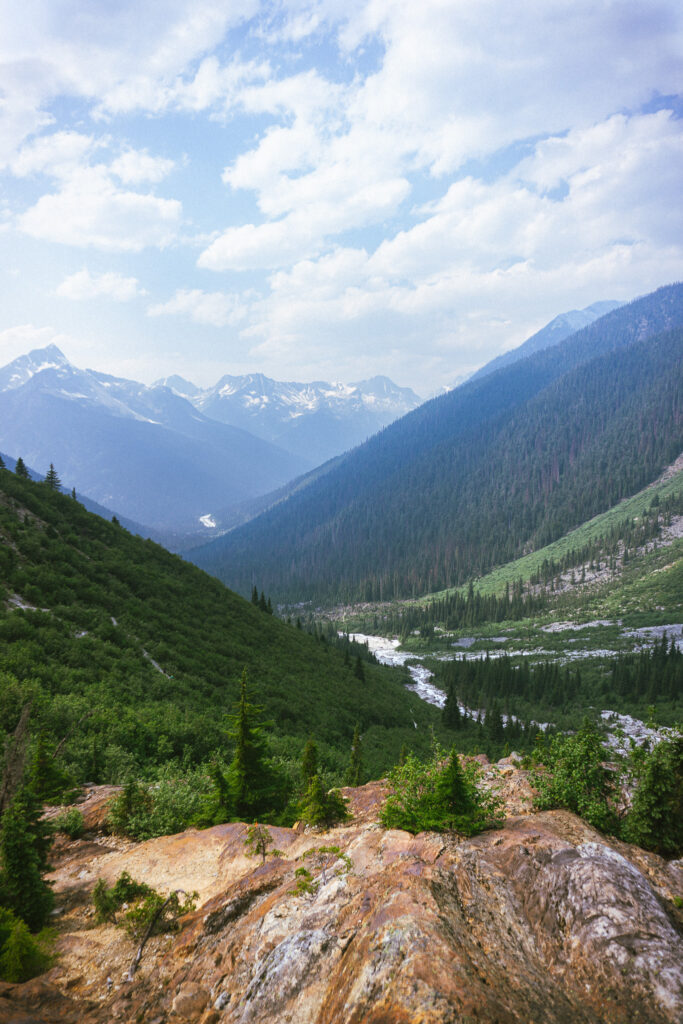
Great Glacier Trail, Glacier NP Canada
You’ll end day two gathered around a campfire at Loop Brook or Illecillewaet Campground. Both campgrounds offer flush toilets, free firewood (if no bans are in effect) and cozy warming shelters if the weather isn’t in your favor.
Day 3 – Glacier NP to Kootenay NP
- Drive Time: 2hr 10min (188.5 km / 117 mi)
- Where to Stay: McLeod Meadows Campground or Marble Canyon Campground
- When to reserve: January of year you want to travel (see Parks Canada for booking date)
- Suggested Stops:
- Golden
- Radium
- Dog Lake Trail
After an adventure-packed Day 2, Day 3 is more of a transition day, taking you from Glacier into Kootenay National Park. With about a 2-hour drive, you’ll have time to stop in either Golden or Radium for lunch — and if you’re in the mood for some relaxation, a soak in the Radium Hot Springs is a great way to recharge.
We stayed at McLeod Meadows Campground. While it’s a bit more rustic, we chose it for its proximity to Floe Lake (Day 4’s adventure). We rolled into camp mid-afternoon, giving us time to explore the nearby Dog Lake Trail before finding a peaceful spot along the Kootenay River to relax for the rest of the day. If you decide to stay here, you’ll find it much quieter than most other national park campgrounds — the perfect, peaceful home base for the next two nights.
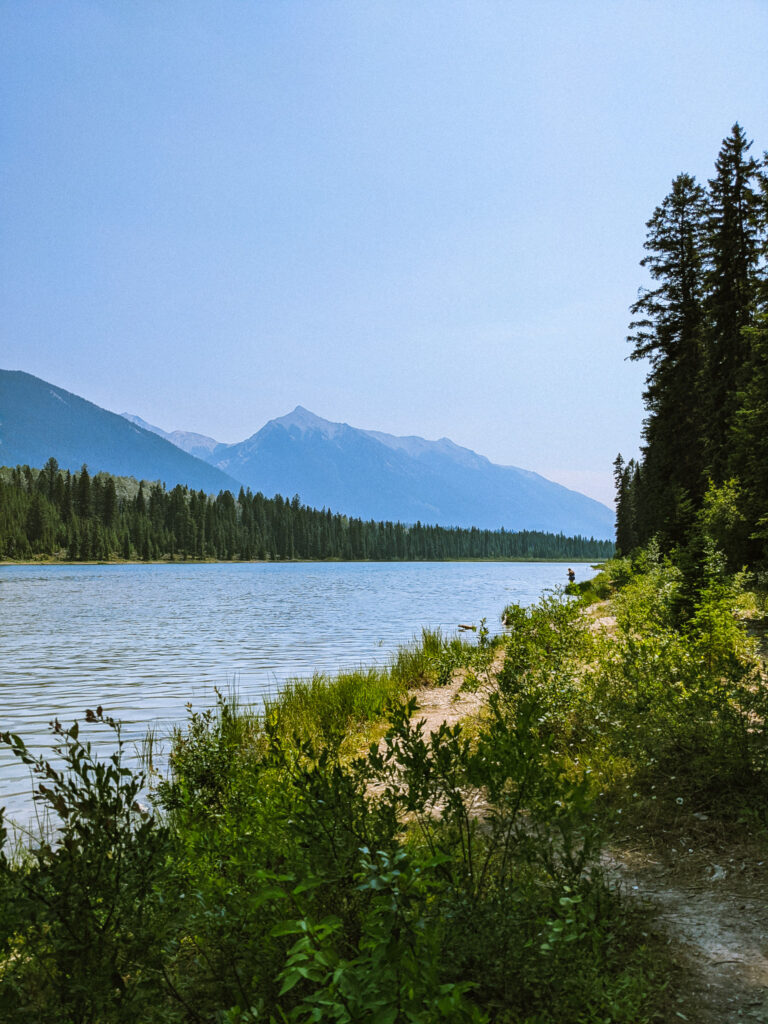
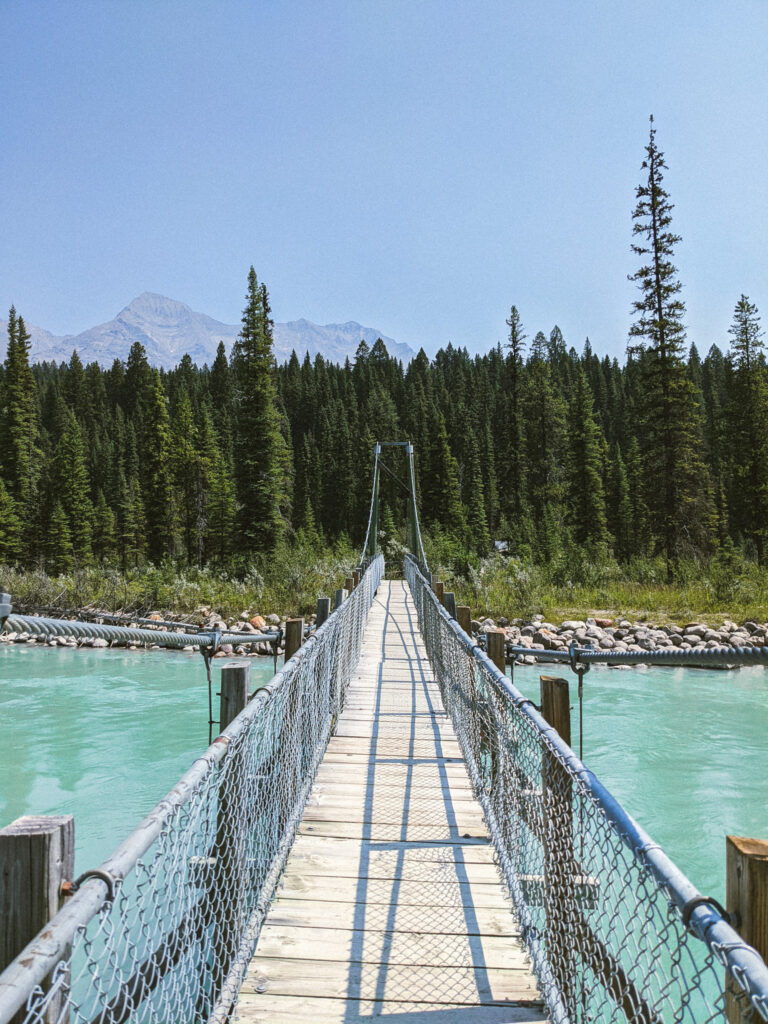
Views along the Dog Lake Trail in Kootenay, NP
Day 4 – Kootenay NP
- Where to Stay: McLeod Meadows Campground or Marble Canyon Campground
- When to reserve: January of year you want to travel (see Parks Canada for booking date)
- Suggested Sights:
- Floe Lake Trail
Hopefully, you got a good rest the night before, because Day 4 is a doozy. After a hearty breakfast, you’ll pack up your day-hiking gear and head to the Floe Lake Trailhead. This hike can be done as an overnight trip, but we chose to tackle the 20 km out-and-back in one day. I’d only recommend this if you’ve got solid trail experience and are in good shape — while the trail isn’t technically difficult, it took us over 8 hours to complete, and we were exhausted afterward.
If you’re up for the challenge, the Floe Lake Trail is absolutely worth every step. The first 8 km are relatively easy and incredibly beautiful, winding along a flat mountain-side trail, through wildflowers, with the river flowing below. We took our time here, stopping for plenty of photo breaks.
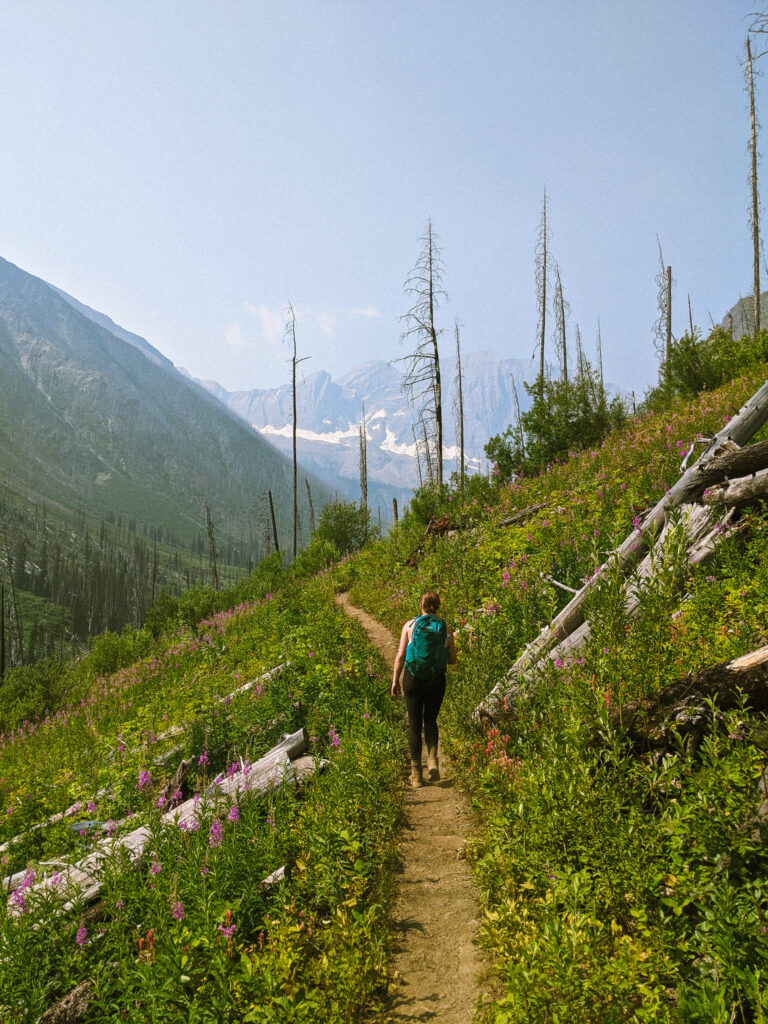

The stunning start of the Floe Lake Trail.
Just past the 8 km mark, the climb to Floe Lake starts almost abruptly, as the open alpine trail turns into steep, forested switchbacks. Almost immediately, we were swarmed by horseflies and bugs — none of which had bothered us earlier. At this point, our bug hats became lifesavers (seriously, don’t leave those behind).
After battling flies and tackling steep switchbacks for 2 km, we finally reached the breathtaking Floe Lake. Turquoise waters set against glacier-capped peaks — the kind of view that instantly makes every step feel worth it. We enjoyed lunch by the shore and even braved a quick (and icy!) dip, but the relentless horseflies kept us from lingering too long in our bathing suits.
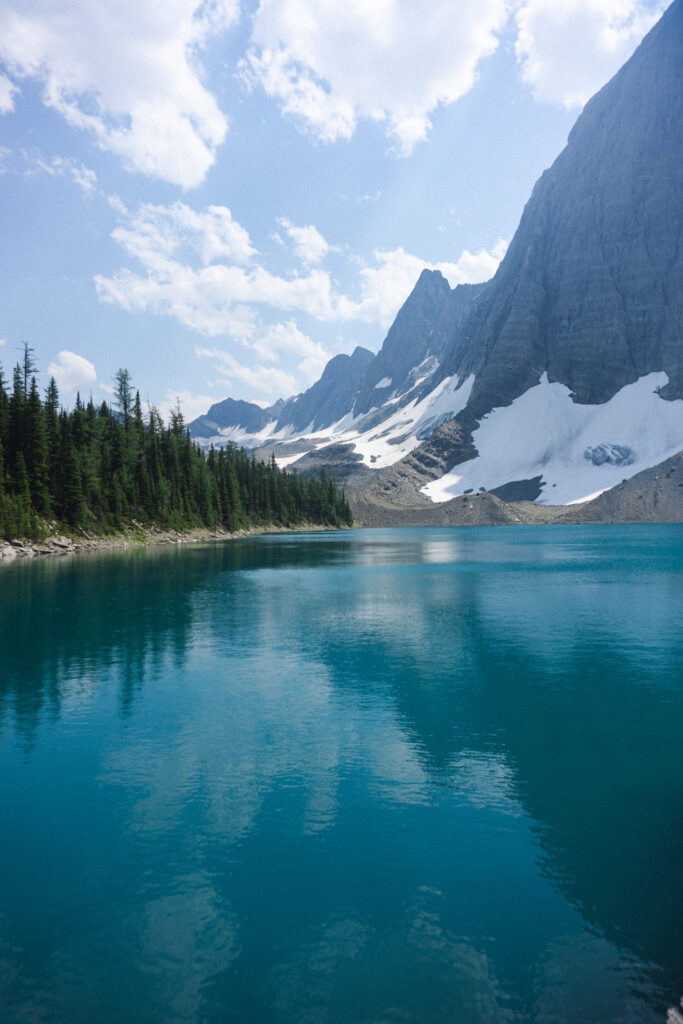

The majestic shores of Floe Lake.
The return trip feels quicker — those steep switchbacks are much more fun going down — but after a full day of hiking, your legs will definitely be feeling it. Luckily, staying at McLeod Meadows means a short drive back to camp, where a well-earned dinner and a long night’s rest await.
Day 5 – Kootenay NP to Banff NP
- Drive Time: 1hr 15min (117 km / 72 mi)
- Where to Stay: Two Jack Lake Main, Tunnel Mountain Village, Two Jack Lakeside or Johnston Canyon Campground
- When to reserve: January of year you want to travel (see Parks Canada for booking date)
- Suggested Stops:
- Banff (city center)
- Two Jack Lake
- Johnston Canyon
After your big adventure the day before, Day 5 takes you across the provincial border into Banff National Park. Banff is arguably the most popular of the Canadian Rockies national parks, and you’ll notice it’s much busier — both in the campgrounds and on the trails — compared to Kootenay, Glacier, and Revelstoke.
The drive into Banff is short, giving you plenty of time for stops along the way before setting up camp for the night. We made a detour into the town of Banff, happily swapping out our cooler sandwiches for a proper lunch (and a couple of beers). After fueling up, we took a refreshing dip in Two Jack Lake and made a quick visit to Johnston Canyon. Unfortunately, an abrupt thunderstorm cut our time at Johnston Canyon short, luckily just after we got a chance to snap a few pics.

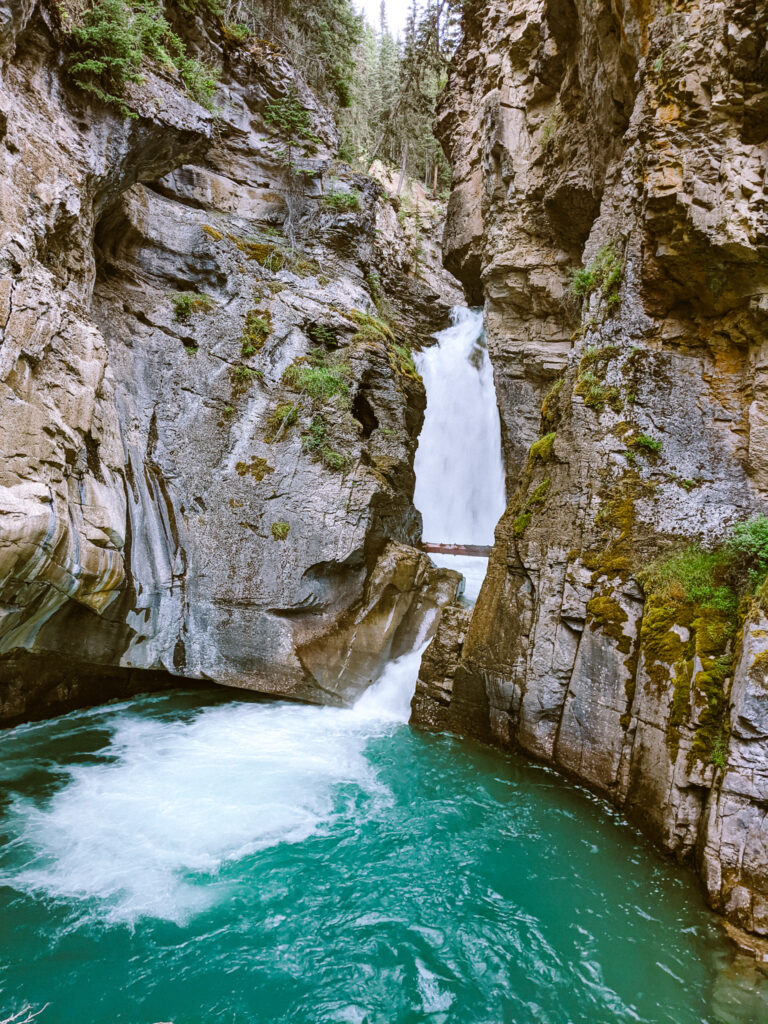
Two Jack Lake and Johnston Canyon, before the rains came.
There are tons of great places to camp or stay in Banff. We chose Two Jack Main Campground, but really, any of the options will put you close to some of the park’s best adventures.
Day 6 – Banff NP
- Where to Stay:
- Camping: Two Jack Lake Main, Tunnel Mountain Village, Two Jack Lakeside or Johnston Canyon Campground
- When to reserve: January of year you want to travel (see Parks Canada for booking date)
- Hotel: Lake Louise Inn
- Camping: Two Jack Lake Main, Tunnel Mountain Village, Two Jack Lakeside or Johnston Canyon Campground
- Suggested Stops:
- Lake Minnewanka
- Lake Louise
- Little Beehive
If you’re camped at Two Jack Main Campground (like we were), it’s super easy to kick off your day with a quick trip to Lake Minnewanka. We drove, but Parks Canada also offers a convenient bus that stops at both the campground and the lake. We only had a short window to explore, but if you’ve got more time, I highly recommend hiking along the shoreline or soaking in the views from the water by canoe, paddleboard, or boat tour.
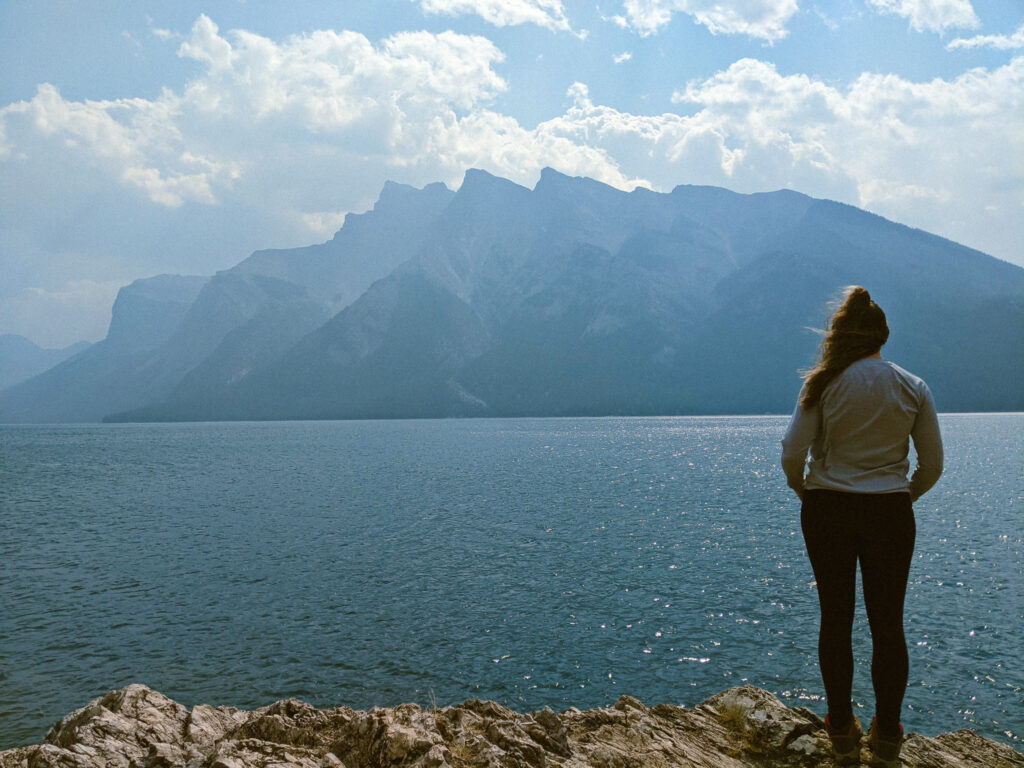
From there, we made our way to the iconic Lake Louise. You can either drive or take the bus—whatever works best for your schedule. Just a heads-up: Lake Louise is one of the most popular spots in the Canadian Rockies, so it gets busy. We struggled to find parking — and finding a quiet spot along the shore proved even harder. At the time of our visit, driving was our only option, but Parks Canada has since added shuttles and other ways to get there. If Lake Louise is a must-see on your list, I’d suggest booking a spot on the Parks Canada shuttle or using Roam Public Transit to ensure you don’t miss it.
While the lake itself didn’t totally wow us from the shoreline, we found a new appreciation for it once we hiked up to Little Beehive. The trail starts from Lake Louise and follows the popular Lake Agnes route, passing the famous tea house before climbing to the summit. From the top, you get an incredible view of the lake below—honestly, that’s where Lake Louise really shined for us. Most hikers seemed to stop at Lake Agnes, so we had Little Beehive almost completely to ourselves, making our experience feel that much more special.
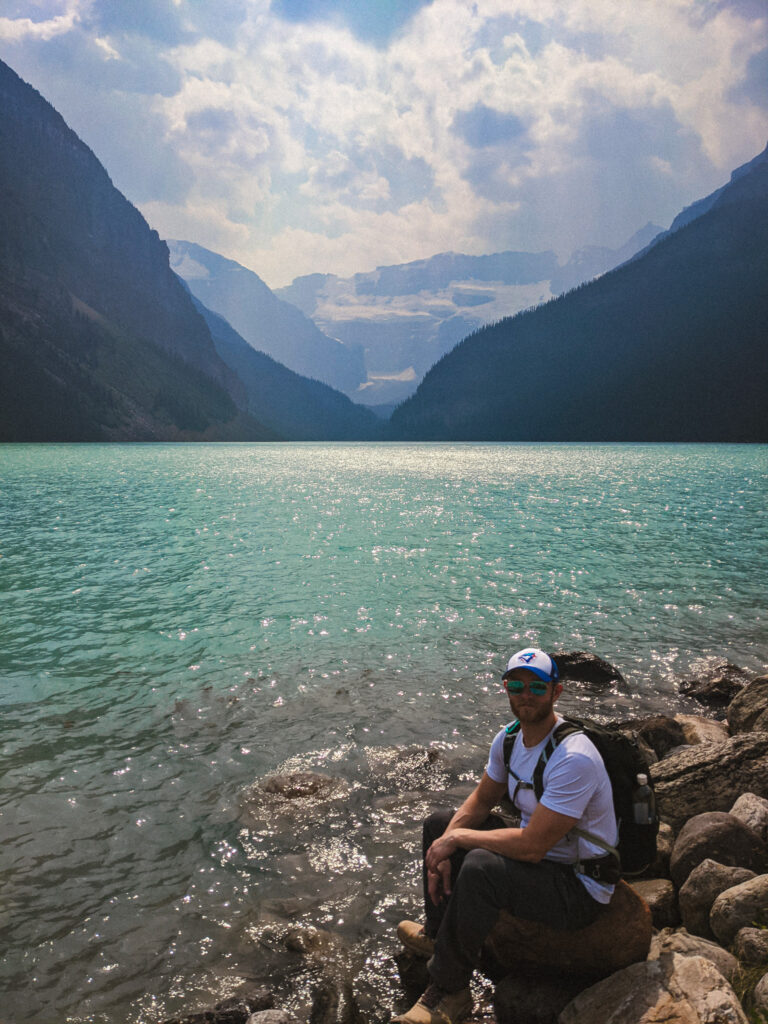

Lake Louise from the shore, vs. Lake Louise from the top of Little Beehive.
Day 7 – Banff NP to Jasper NP
- Drive Time: 3hr 12 min (288 km / 178 mi)
- Where to Stay:
- Camping: Whistlers, Wapiti or Kerkeslin Campground
- When to reserve: January of year you want to travel (see Parks Canada for booking date)
- Camping: Whistlers, Wapiti or Kerkeslin Campground
- Suggested Stops
- Emerald Lake
- Natural Bridge
- Icefields Parkway
After a week on the road, you’ll finally reach one of the most iconic drives in the Canadian Rockies — the Icefields Parkway. This stunning stretch of highway connects Banff to Jasper and is widely known as one of the most scenic routes in all of Canada.
Before tackling the 3-hour drive, we took a slight detour back into BC to explore a few sights in Yoho National Park. While it added a bit of extra time to our day, it was absolutely worth it. At Emerald Lake, we wandered along the shoreline trail, soaking in the peaceful views, while others paddled across the turquoise water in those famous red canoes. Despite some haze from nearby wildfires, the lake was still breathtaking — its vibrant shores glowing even under smoky skies.


Emerald Lake from all the many vantage points.
Along the Icefields Parkway, we made a stop to check out the glacier on our own, but you can also book a tour that takes you right onto the ice, where you can walk on the glacier and experience it up close.
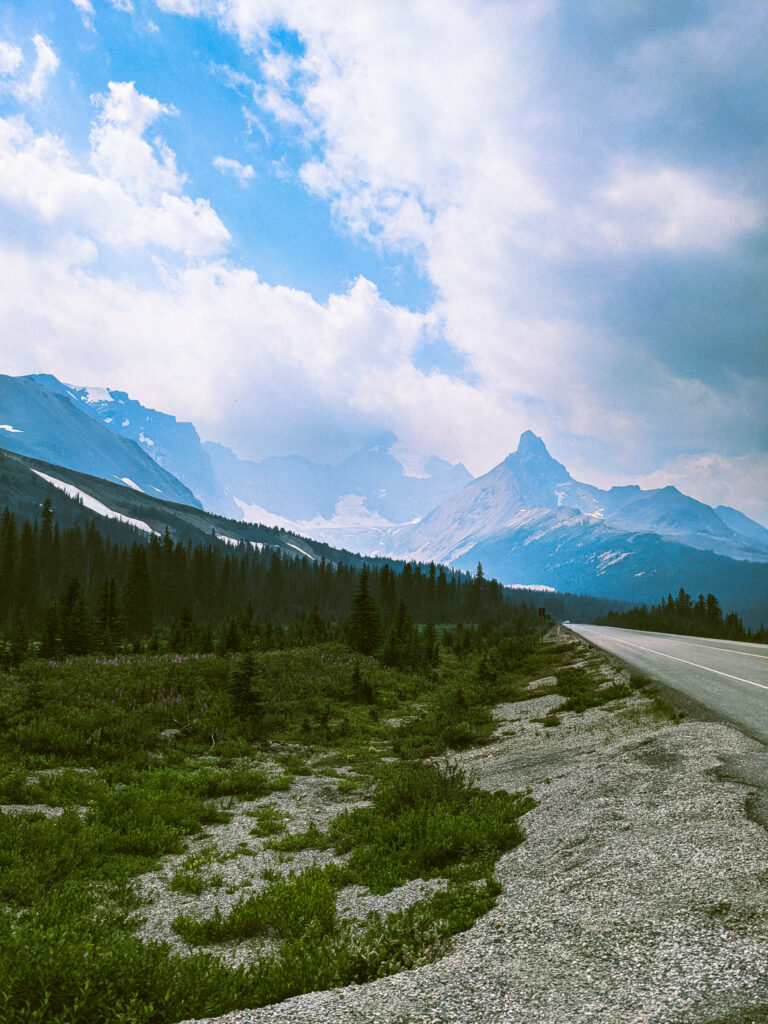
We camped at Wabasso Campground, which is currently closed due to the 2024 Jasper wildfire. Luckily, Jasper National Park still offers several front-country campgrounds, so you’ll have no trouble finding a place to pitch your tent and take in the beauty of the Rockies.
Day 8 – Jasper NP
- Where to Stay:
- Camping: Whistlers, Wapiti or Kerkeslin Campground
- When to reserve: January of year you want to travel (see Parks Canada for booking date)
- Camping: Whistlers, Wapiti or Kerkeslin Campground
- Suggested Stops
- Mt. Edith Cavell
With so much to see and do in Jasper, we opted for a two-night stay. On our second day, we hit the trails to explore Mt. Edith Cavell — one of our favourite hikes in the Rockies.
As of now, the road to Mt. Edith Cavell is closed due to the 2024 wildfires, which is a real loss for visitors, as this trail is truly unforgettable. Along the hike, you’re treated to stunning views of the glacier and its turquoise, glacier-fed lake the entire way. You can even make your way down to the shore and touch the floating chunks of ice that have broken off from the glacier. During our visit, we could hear the glacier cracking and shifting under the warmth of the mid-day sun — a surreal experience. If you’re planning a trip to Jasper, be sure to check the Parks Canada website for updates on trail and road openings. If it’s accessible, don’t miss it.
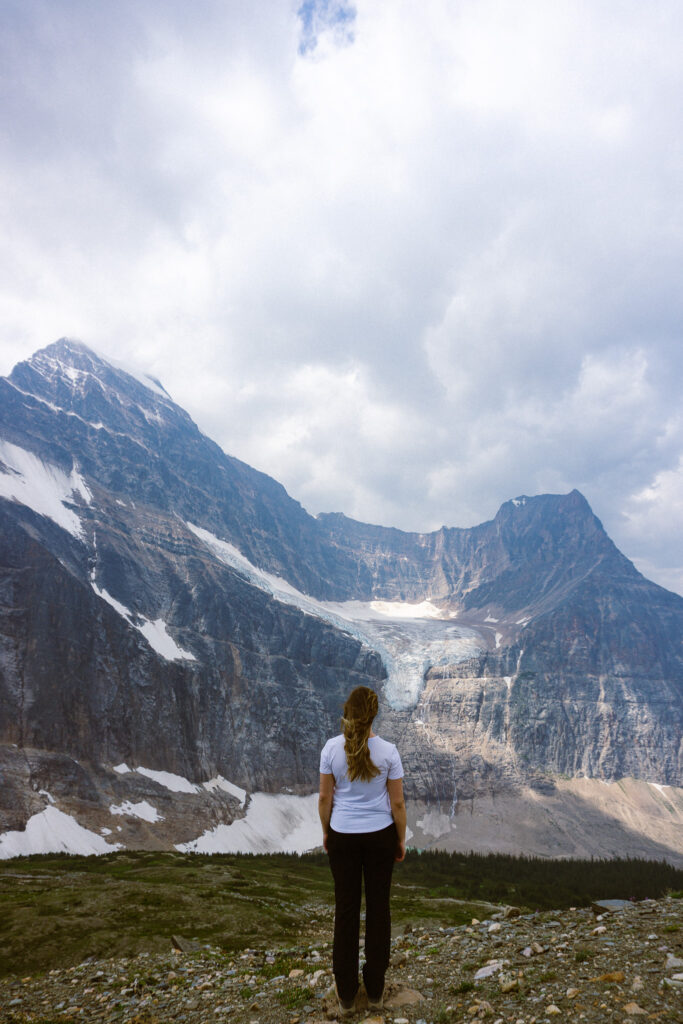
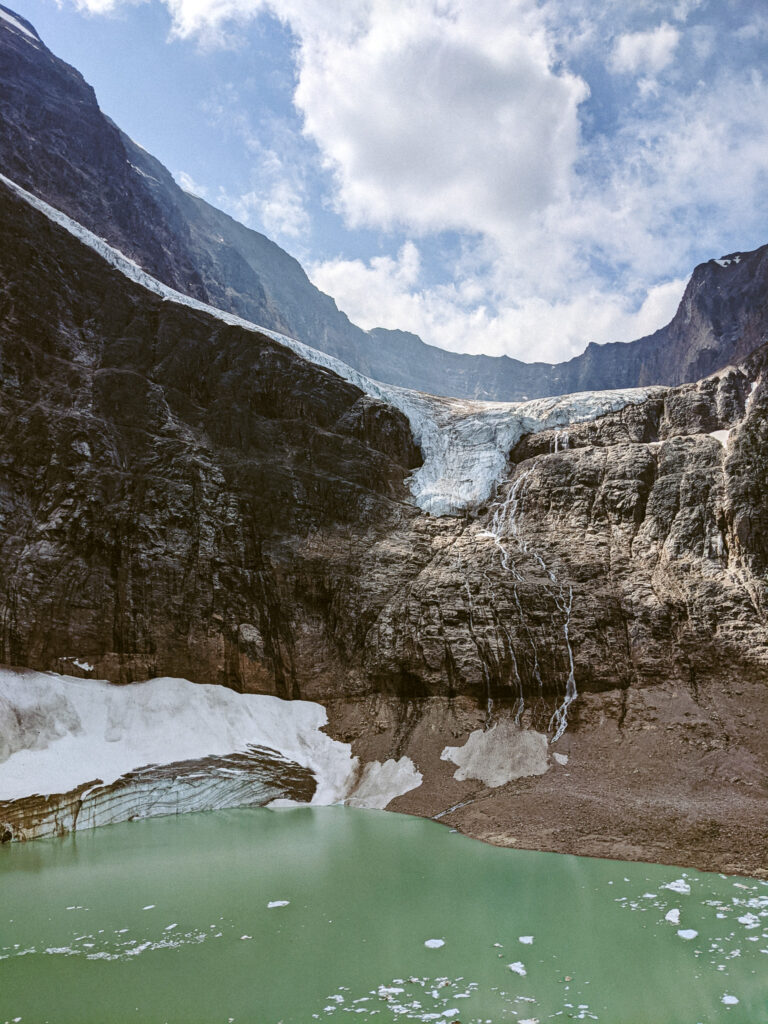
Views along the Mt. Edith Cavell Trail.
That said, there are countless other day hikes around Jasper worth exploring. You can find a full list of trails and current conditions on the Jasper National Park page — it’s a great resource to help plan your adventure.
Day 9 – Jasper
- Where to Stay:
- Camping: Whistlers, Wapiti or Kerkeslin Campground
- When to reserve: January of year you want to travel (see Parks Canada for booking date)
- Camping: Whistlers, Wapiti or Kerkeslin Campground
- Suggested Stops
- Maligne Canyon
- Pyramid Island
- Maligne Lake to Spirit Island
- Medicine Lake
Originally, this was meant to be our final night in Jasper before heading east to take on the Berg Lake Trail in Mt. Robson Provincial Park. But, as I mentioned earlier, those plans were abruptly derailed when major sections of the Berg Lake Trail were washed out and severely damaged.
Though we were disappointed, we made the most of the change by extending our time in Jasper. We spent the day exploring Maligne Canyon and stayed overnight at the Mt. Robson Inn—both of which, sadly, have since been damaged and closed due to the 2024 wildfire. That said, Jasper still has so much to offer that filling your day won’t be a challenge. If you find yourself with an extra day, I highly recommend driving out along Maligne Lake Road. You can rent a canoe or treat yourself to a cruise out to Spirit Island. While I haven’t made it there yet, it’s been on my bucket list for years and looks absolutely stunning.
After several days of camping, we decided to splurge on a hotel for night 9 and spent some time exploring the town of Jasper. While the hotel we stayed at has since closed due to the wildfire, Jasper still has plenty of cozy accommodations and great places to eat.

Day 10 – Jasper NP – Backcountry
- Where to Stay:
- Backcountry Camping: Jaques Lake Campground
- When to reserve: January of year you want to travel (see Parks Canada for booking date)
- Backcountry Camping: Jaques Lake Campground
Still craving a backcountry adventure after our Berg Lake cancellation, we scrambled to find a last-minute trail in Jasper where we could hike and camp overnight. Our first choice would have been the iconic Skyline Trail, but thanks to its popularity, it’s typically fully booked by January for the entire summer season. Instead, we landed on the Jaques Lake Trail—a 12.2 km (one way) moderate trail that’s perfect for a 1-2 night trip.
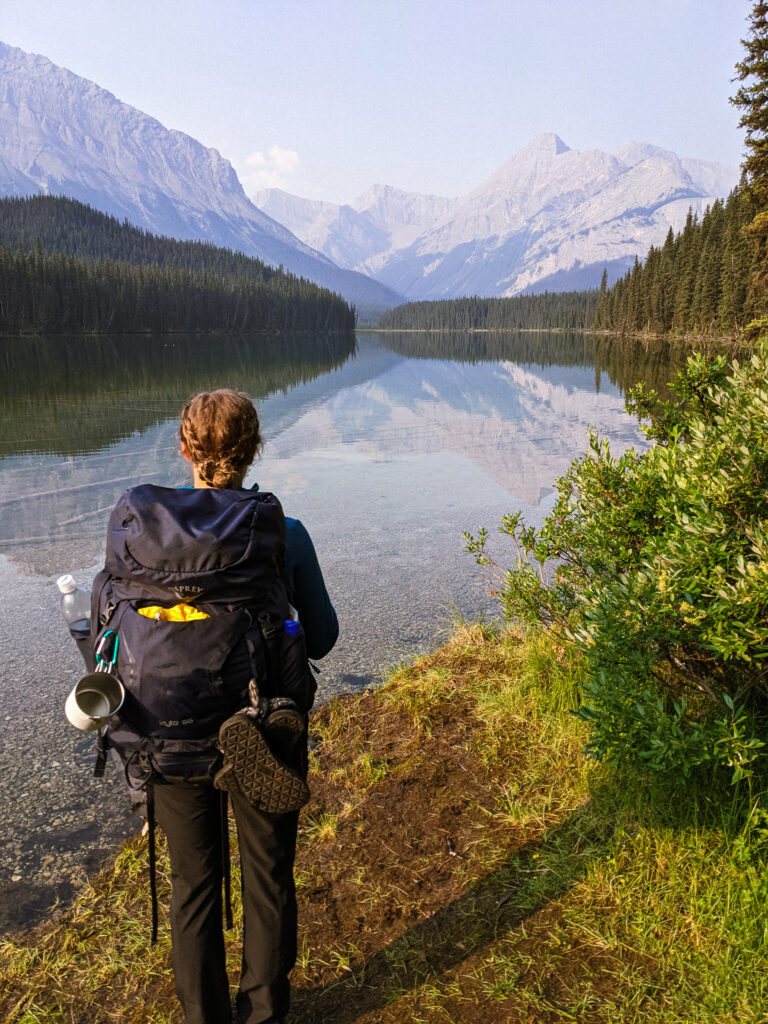
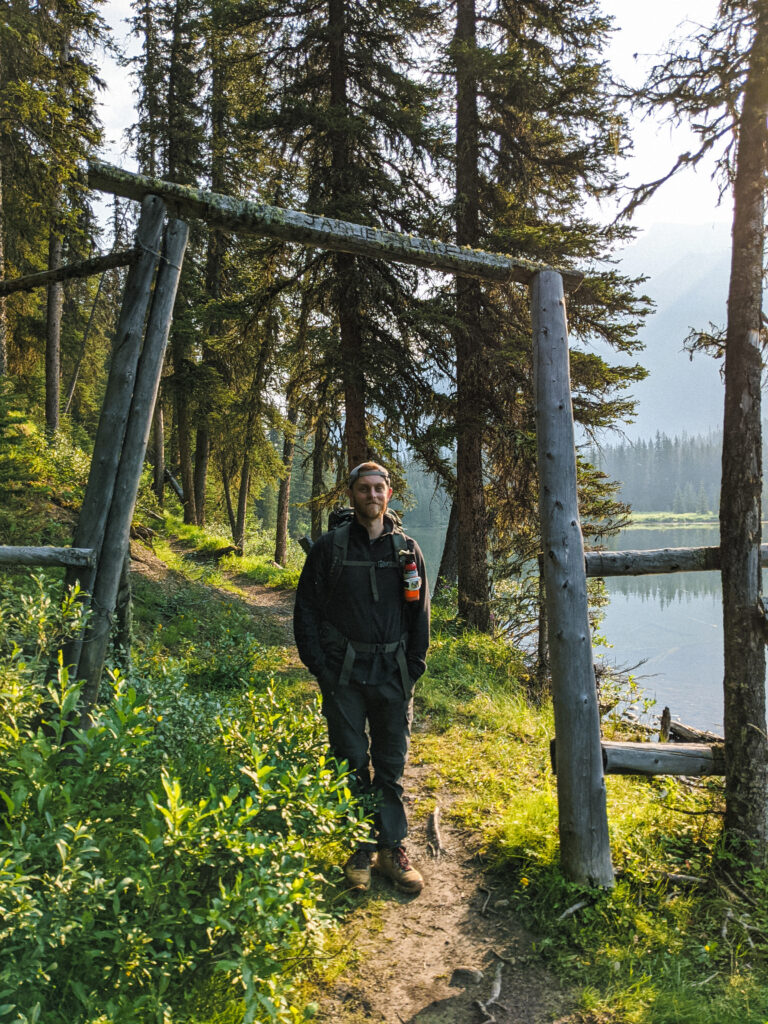
Jaques Lake is definitely one of Jasper National Park’s quieter backcountry routes. Even in mid-July, we barely passed anyone on the trail, and at the campground, we shared the entire site with just one other group of hikers. If you’re seeking solitude, this trail absolutely delivers.
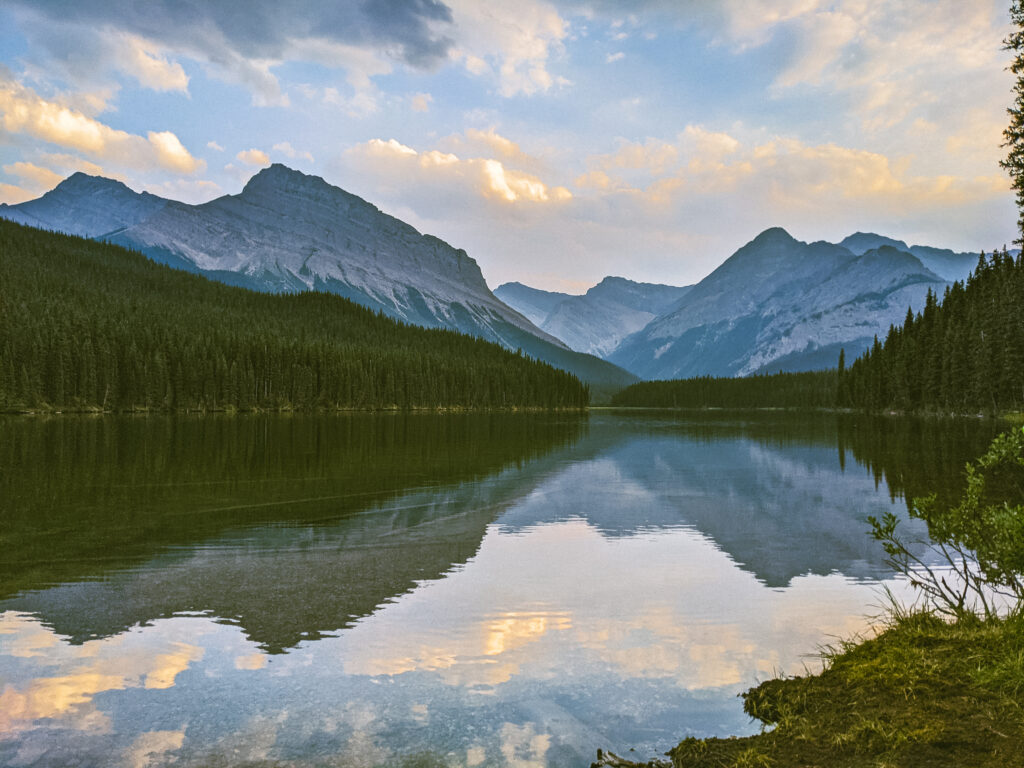
While we didn’t run into many people, we did encounter an incredible amount of wildlife. Within the first 2 km, we’re pretty sure we heard a moose rustling in the bushes, and the trail was scattered with all kinds of animal tracks and droppings the whole way up. The next morning, while sipping our coffee at the campsite, we were treated to an unforgettable sight—two moose feeding right in the lake. Hands down, one of the most magical wildlife moments I’ve ever experienced.
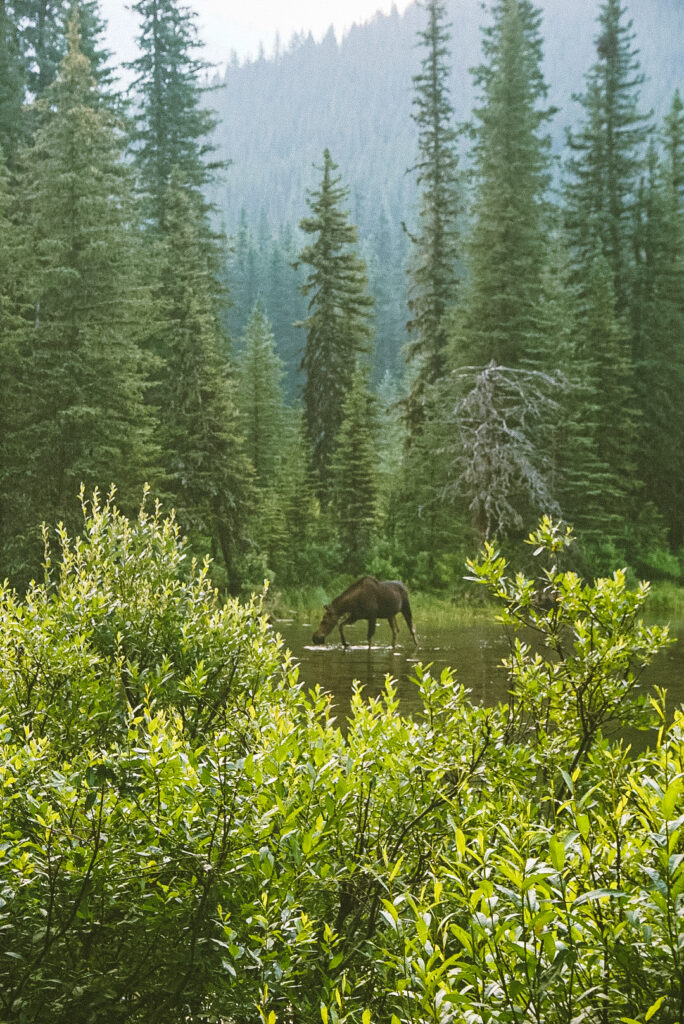
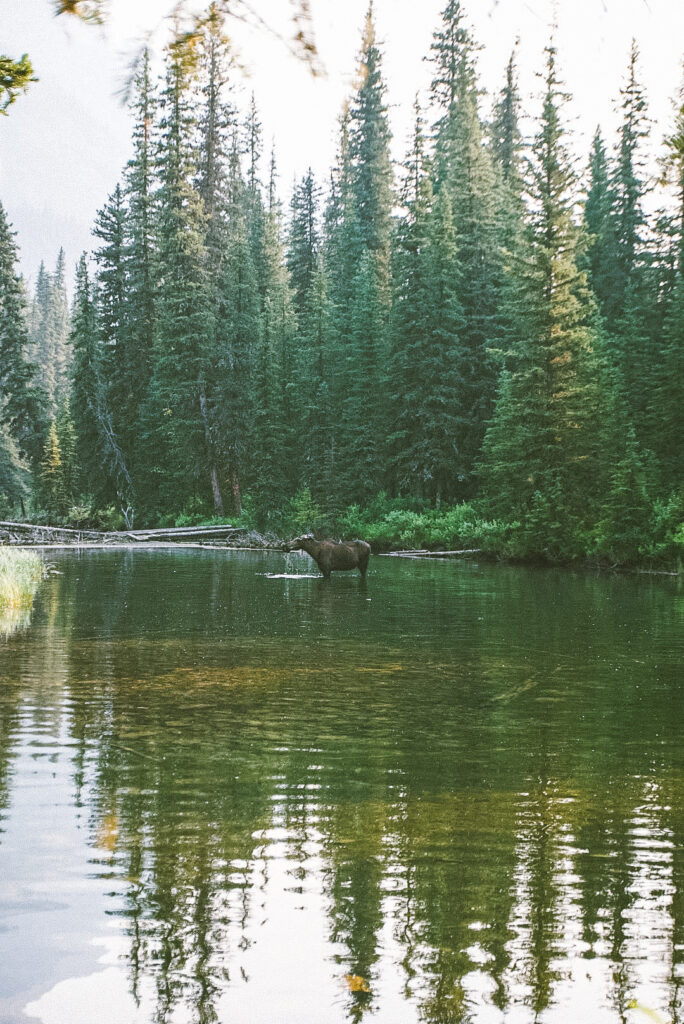
Majestic morning watching moose at Jaques Lake.
Day 11 – Jasper NP – Backcountry to Mt. Robson
- Drive Time: 1 hr 30 min (120 km / 74.5 mi)
- Where to Stay:
- Camping: Robson Meadows Campground
- When to reserve: 4 months before stay date (see BC Parks website for booking information)
- Camping: Robson Meadows Campground
- Suggested Stops
- Kinney Lake Trail
Though most of the Berg Lake Trail was still closed, we couldn’t resist ending our trip by at least catching a glimpse of Mt. Robson from afar. So after hiking out of the Jacques Lake Trail on the morning of Day 11, we crossed back into BC and spent the night at Robson Meadows Campground.
If your legs aren’t completely wiped from the previous days adventure, you can hike the first section of the Berg Lake Trail up to Kinney Lake. It’s a beautiful and rewarding route, and you have the option to camp at the Kinney Lake backcountry site or return to the comfort of the front-country Robson Meadows Campground. And of course, no trip to Kinney Lake is complete without dipping your toes in its icy, teal-green waters.
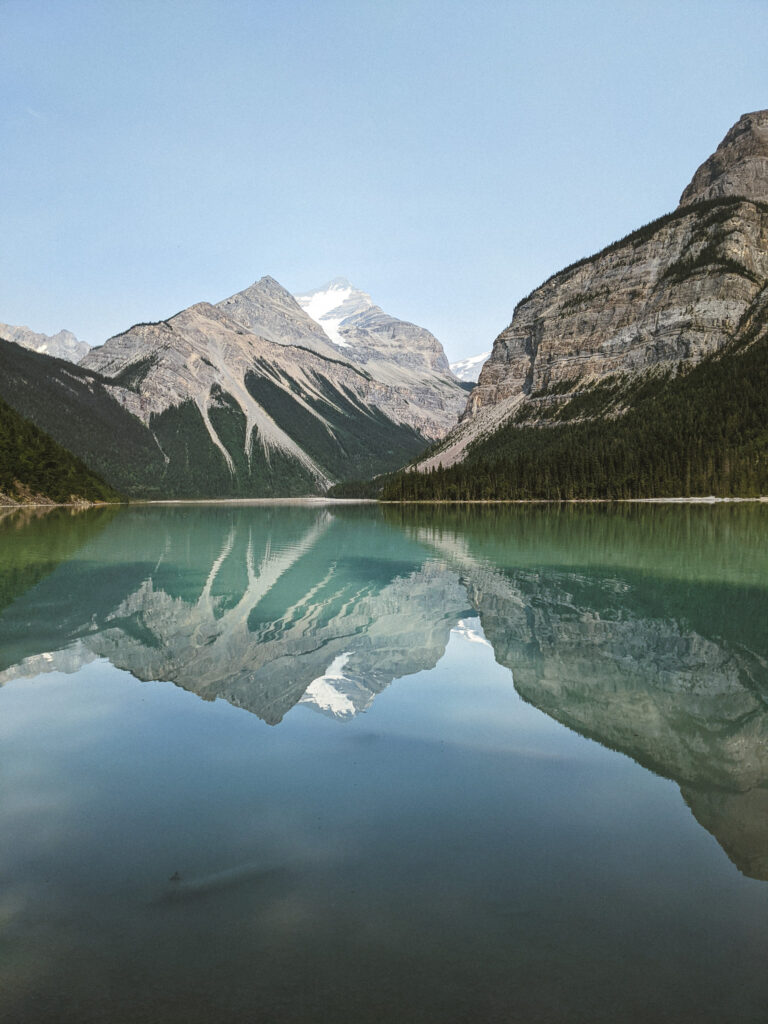

Day 12 – Mt. Robson to Vancouver
- Drive Time: 7 hr 25 min (709 km / 440.5 mi)
- Suggested Stops
- Sun Peaks
As you near the end of your trip, you might be tempted to make the long haul straight back to Vancouver from Mt. Robson. While it’s definitely a big drive day, it’s still manageable. We chose to break it up with a night in Sun Peaks, but there are plenty of great spots to stop along the way.
If you’re looking to extend the adventure a little longer, you could swing by Wells Gray, known for its spectacular waterfalls, spend a night in Kamloops, or take a detour to Harrison Hot Springs. There’s no shortage of scenic stops and charming towns to break up the drive along this major BC route.
You’ll never regret a trip through the Canadian Rockies. With their towering peaks and mesmerizing glacier-fed lakes, these iconic landscapes are a dream for any explorer. And even if your plans shift along the way, however you choose to spend your time here is bound to feel magical. I hope this route and itinerary help you discover your own unforgettable adventure in the heart of the Rockies.

